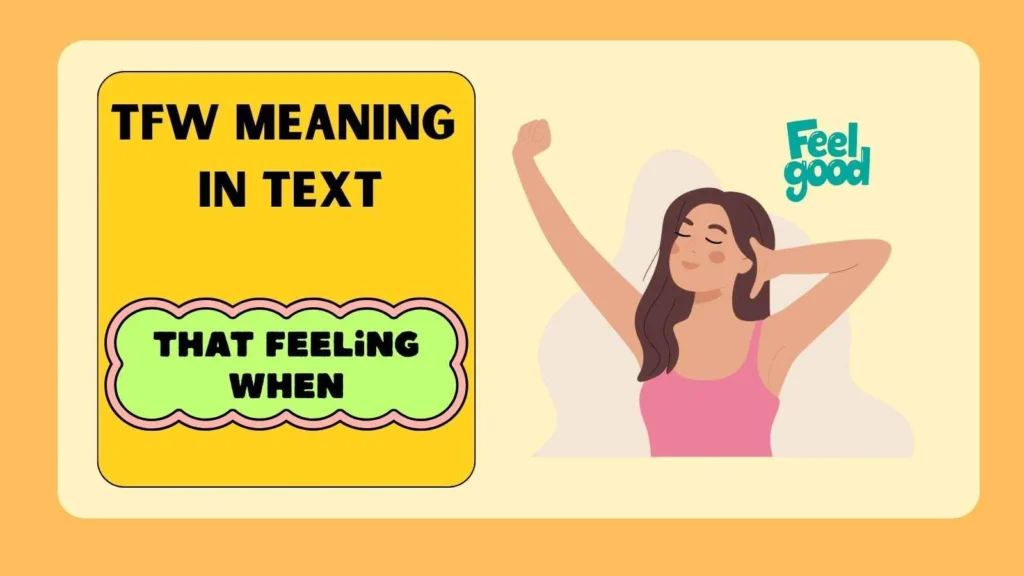In the fast paced world of texting, social media, and online chats, acronyms have become an essential way to express feelings quickly. One such term that often sparks curiosity is “tfw”. People frequently encounter it in memes, tweets, or casual text messages, prompting them to ask, “What does tfw mean in text?”
Essentially, tfw meaning in text captures emotions and reactions in just three letters, allowing users to convey a sense of nostalgia, excitement, sadness, or irony without typing long sentences.
Understanding this term not only helps in decoding modern digital conversations but also makes your online communication feel more relatable and current.
Whether you’re a Gen Z social media enthusiast or someone trying to stay updated with texting lingo, grasping the nuances of tfw is essential for effective digital communication.
Definition & Meaning
The acronym TFW stands for “That Feeling When”. It’s commonly used to preface a relatable emotion, reaction, or situation in a concise, impactful way. For example, someone might write:
tfw you realize the weekend is over
Here, tfw emphasizes the emotional reaction—disappointment, in this case—without needing a long explanation. Unlike other acronyms like LOL or BRB, tfw focuses on evoking a shared feeling or moment. Its simplicity and versatility make it widely used across texting platforms, social media, and even comment sections.
Background & History
The term tfw originated from internet culture and meme communities in the early 2010s. It gained popularity on platforms like 4chan, Reddit, and Tumblr, where users often paired it with reaction images or gifs to amplify the emotional effect.
Over time, tfw became a standard expression for succinctly communicating emotions online. Unlike abbreviations that stem from professional or functional contexts, tfw is entirely casual and expressive, reflecting the rise of internet-driven language that prioritizes relatability and humor.
Usage in Various Contexts
TFW is highly versatile and can be applied to numerous situations:
- Social Media: People use it in captions to share memes or personal experiences.
- Texting: It conveys instant emotions in casual chats.
- Gaming Communities: Players use tfw to express in-game reactions or frustrations.
- Memes: Often paired with images to make content more humorous or relatable.
For instance, tfw you finally beat that impossible level communicates a victorious feeling in a compact form. Its usage is universal among digital natives, making it a staple of modern internet slang.
Common Misconceptions & Clarifications
Some newcomers mistakenly think tfw stands for complex phrases or even assume it’s a typo. Others confuse it with tbh (to be honest) or fwb (friends with benefits).
However, its true meaning is simple: That Feeling When. The key is recognizing its emotional context—tfw is not a directive or question but a tool for shared digital empathy.
Similar Terms & Alternatives
There are a few acronyms similar to tfw that express feelings or reactions:
- mfw: My Face When – emphasizes facial reactions.
- tfp: That Feeling of Pride – niche usage.
- tbh: To Be Honest – more opinion-based than emotional.
- smh: Shaking My Head – expresses disapproval rather than feeling.
These alternatives can occasionally overlap in meaning but are context-dependent.
How to Respond to This Term
Responding to tfw usually involves:
- Sharing a relatable emoji: 😩😂😭
- Writing a short acknowledgment: I feel that too!
- Reacting with memes or gifs that match the emotion.
It’s rarely used in formal responses, so casual, empathetic, or humorous replies work best.
Regional or Cultural Differences
While tfw is widely understood in English-speaking countries, its usage may vary culturally:
- In the U.S. and U.K., it’s common among teens and young adults.
- In non-English speaking countries, tfw may be used primarily in gaming or meme communities familiar with Western internet slang.
Some cultures might prefer local equivalents for expressing the same emotion.
Comparison with Similar Terms
TFW vs MFW: Both acronyms relate to emotions, but tfw expresses feelings broadly, while mfw focuses on the facial reaction to a specific event. Understanding this subtle difference helps in choosing the right term for context.
Usage in Online Communities & Dating Apps
TFW has crossed into online dating and casual messaging apps. People use it to express shared experiences or highlight relatable moments in bios or chats, making it an icebreaker in lighthearted interactions. For instance:
tfw you both love the same show
It’s a modern way to connect through emotion-driven shorthand.
Hidden or Offensive Meanings
TFW is generally safe and non-offensive. However, pairing it with controversial or sensitive content could inadvertently create misunderstandings. Context is key: the acronym itself is neutral, but its usage depends on the situation.
Suitability for Professional Communication
TFW is informal by nature and should be avoided in professional emails or business communication. Using it in such contexts may appear unprofessional or confusing to recipients unfamiliar with texting acronyms.
FAQs
What does tfw stand for?
That Feeling When.
Is tfw only for texting?
No, it’s used across social media, memes, and online communities.
Can tfw be offensive?
Rarely, it’s neutral unless paired with sensitive content.
How do I respond to tfw?
Use relatable emojis, short comments, or memes that match the feeling.
Is tfw used professionally?
No, it’s informal and unsuitable for professional communication.
What is the difference between tfw and mfw?
TFW expresses general feelings, while MFW emphasizes facial reactions.
Conclusion
Understanding tfw meaning in text unlocks a crucial piece of modern internet slang. It allows users to communicate emotions succinctly, relate to others online, and participate fully in meme culture.
While casual and expressive, its correct usage can enhance online interactions, from texting friends to engaging in social media communities.
By mastering tfw, you not only stay updated with contemporary digital language but also gain a fun, empathetic tool for everyday online conversations.
